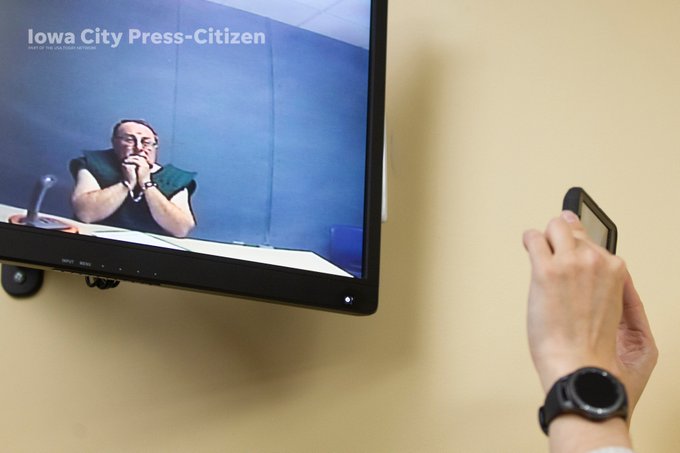
Cedar Rapids Police Michelle Martinko
Michelle Martinko, a Cedar Rapids high school student, was murdered in 1979, and her slaying went unsolved for almost 40 years – until police say they were able to use DNA technology to find Michelle’s killer.
In December 2018, authorities announced that new DNA technology had led to the arrest of the man they now accuse of being Martinko’s murderer. Bail for Jerry Lynn Burns was set at $5 million.
“An investigation by the Police Department identified a suspect in the case. The suspect, identified as Jerry Lynn Burns, DOB/12-23-1953, age 64, of Manchester, Iowa, was arrested today for the crime of Murder in the First Degree,” police alleged in a news release.
“This tragic case has been haunting this community for 39 years,” said the police chief, Wayne Jerman in a news conference on the arrest.
Here’s what you need to know:
1. Martinko, a High School Student, Was Stabbed Multiple Times After Going to a Shopping Mall
A 1979 article in The Des Moines Register described Martinko as a “Cedar Rapids” high school girl and said that her body was discovered in her parents’ car in a shopping center parking lot.
She was an 18-year-old student at John F. Kennedy High School in Cedar Rapids, Iowa, at the time of her death, the old newspaper article reported, adding that she was “stabbed repeatedly in the face and chest.”
The Cedar Rapids police chief confirmed in the news conference, “Michelle Martinko was age 18 at the time of her death and was found stabbed to death. Thirty-nine years ago to day, Michelle Martinko went to the Westdale mall to stop for a winter coat.”
The police chief said Michelle was “brutally stabbed to death. This case was actively investigated for 39 years.”
In the 1979 article, authorities had said they had “no leads” and asked for the public’s assistance. The Des Moines Tribune, in a 1979 article, described the murder investigation as “difficult” and involving an “unknown assailant.” Martinko died around 9 p.m. and was “stabbed at least eight times,” according to the newspaper.
The Tribune article said that Martinko “had attended a school function at the Sheraton Inn and then had phoned home to tell her parents she was going to the mall.” There was no evidence she was sexually assaulted or beaten, police said in that article.
Martinko went to the mall to buy a coat, a 1980 article in the Waterloo Courier reported. In the 2018 press release, Cedar Rapids police said, “By way of background information, it was on December 19, 1979, Michelle Martinko drove her family’s 1972 Buick Electra to Westdale Mall to shop for a winter coat after leaving a school banquet at approximately 6:30 p.m. that evening. Martinko’s parents reported her missing around 2:00 a.m. on December 20, 1979. Police found the Buick in the northeast section of the Westdale Mall parking lot shortly after 4:00 a.m.”
2. Martinko’s Mother Says Michelle Was ‘a Religious Girl’
The murder had a severe impact on Martinko’s family.
I cried a lot and I looked out windows all hours of the night and I talked to myself and didn’t know what to do,” said Janet Martinko, Michelle’s mother, two years before a suspect was accused. “Then you have to pray… strive for religion, because she was a religious girl and that makes me feel good.”
Michelle had taken a self defense class, and she was involved in school choir, according to The Des Moines Register.
“We did choir and classes and things like that,” said friend Elizabeth Laymon to KCRG-TV. “I can still vividly remember her laugh.”
3. Jerry Burns Now Stands Accused of Murdering Michelle Martinko Based on Blood Found in Her Car
On December 20, 2018, the Cedar Rapids Police Department wrote on Facebook, “The suspect makes an initial appearance this morning at 9:30 a.m. Police announced the arrest of a suspect in the murder of Michelle Martinko last evening. Michelle was found stabbed to death in her family’s Buick on December 20, 1979.”
In a news release, police wrote that a criminal complaint was filed by the Linn County Attorney’s Office charging Jerry Lynn Burns, age 64, of Manchester, IA, with Murder in the First Degree.
Police recovered DNA from the crime scene. “On December 19, 1979, Michelle Martinko, age 18, was last seen alive at Westdale Mall, 2600 Edgewood Rd. SW, Cedar Rapids, Linn County, Iowa. On December 20, 1979, a Cedar Rapids Police Officer found her deceased in her parents’ vehicle parked at Westdale Mall. Ms. Martinko suffered multiple stab wounds that caused her death,” police wrote.
“Clothing worn by Martinko was later analyzed by the DCI Crime Laboratory and blood was found that did not belong to Martinko. A partial male DNA profile was developed from this blood stain and fewer than one in one hundred billion unrelated individuals would have this same profile.”
According to the police, “Another partial male DNA profile was developed from blood found on the gear shift knob of the vehicle in which she was found. Cedar Rapids Police utilized DNA genetic genealogical research to narrow profile down to a specific pool of suspects, which included the defendant. Cedar Rapids Police collected covert DNA from the defendant which was sent to the DCI Crime Laboratory for analysis.”
Police allege that the “DCI Crime Laboratory found that the covertly collected DNA from the defendant was a match to the DNA from the blood found on Martinko’s clothing and consistent with the DNA profile developed from the blood found on the gear shift knob of the vehicle.”
4. For Years, Authorities Pleaded for Leads & Martinko’s Dad Tried to Hold the Shopping Mall Accountable
For years, police were vexed by the case, sometimes admitted they had no leads.
“I know people are tired of hearing this, but please, for God’s sake, to the people out there, if you saw anything – no matter how insignificant – please call us,” the assistant chief of police said in 1979 to a local newspaper.
In 1986, according to The Des Moines Register, a “divided Iowa Supreme Court” rejected a claim from Martinko’s father, Albert F. Martinko, that the shopping mall was negligent because it didn’t provide “reasonable security” for Michelle Martinko.
Police Chief Wayne Jerman said in the 2018 news release, “Last year, I had the opportunity to spend some time with Michelle Martinko’s sister, Janelle, along with her husband, John Stonebraker. They were so grateful to the Police Department for continuing to work on this case. The family never gave up hope that this case would be solved. Today’s announcement makes it clear that this Police Department and our investigators never gave up on this case either. I am very appreciative of the work of our investigators and their persistence with this case, including the use of the latest technology that can aid in the investigation regardless of how long ago the violent act occurred.”
5. Burns Is Accused of Not Being Able to Explain Why His DNA Would Be found at the Crime Scene
According to Cedar Rapids police, “The defendant was interviewed at his place of employment in Delaware County on December 19, 2018. The defendant initially denied being present at the crime scene on the night of the murder and ultimately claimed he did not have any recollection of committing this crime and could not offer any plausible explanation why his DNA would be found at the crime scene.”
Cedar Rapids police had tried to enter the suspect’s DNA years ago in an offender database and never got a hit.
“Cedar Rapids police investigators have continued to work the case over the past 39 years. On October 2, 2006, cold case investigators announced new evidence, the suspect’s DNA, was developed in the case. The DNA was uploaded in the Combined DNA Index System (CODIS), a national database that houses DNA profiles developed from crime scenes,” police wrote. “When profiles of convicted offenders are uploaded to the database, CODIS searches its current index system to see if the offender’s DNA matches a profile in an unsolved crime. Investigators never received a match through CODIS.”
Investigators sought the services of Parabon NanoLabs, “a company that specializes in DNA phenotyping, the process of predicting physical appearance and ancestry from unidentified DNA evidence. They produced trait portraits for the associated person of interest. Predictions were made for ancestry, eye color, hair color, skin color, freckling, and face shape. The Cedar Rapids Police Department released the composites at a press conference on May 16, 2017.”
They eventually used the DNA to identify Burns as a suspect. The police department obtained “covert DNA” from the suspect. The laboratory found that the DNA was a match to the DNA from the blood found on Michelle’s clothing and consistent with the DNA profile developed from blood also found elsewhere in the vehicle, police allege.
Parabon uses genetic genealogy to solve cases, a process used in the Golden State Killer case.
A motive for the Michelle Martinko murder has not been released.








